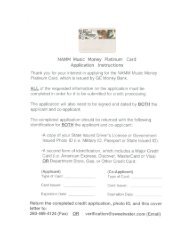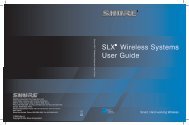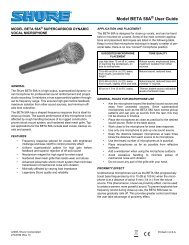Create successful ePaper yourself
Turn your PDF publications into a flip-book with our unique Google optimized e-Paper software.
Backing Track Functions<br />
Back up User Style<br />
(Exporting to USB memory)<br />
For details, refer to “Saving User Data to USB Memory<br />
(Backup)” (p. 49).<br />
Using the Recommended Sound<br />
Settings for a Style ([ONE TOUCH])<br />
When [STYLE] is on, turning [ONE TOUCH] on (button lit) will<br />
assign the most suitable Tones for the currently selected Style<br />
as the Upper Tone and Lower Tone. This is called the “One<br />
Touch” function.<br />
If [ONE TOUCH] is on when you switch Styles, the keyboard<br />
Tones will also switch to the Tones that are most suitable for<br />
the Style you selected.<br />
To turn off the One Touch function, turn [ONE TOUCH] off<br />
(button unlit).<br />
Song<br />
Recording a New Song ([SONG REC])<br />
You can use the 16-track recorder of the GW-8 to record your<br />
own performances.<br />
You can record your keyboard performance while listening to<br />
an accompaniment, and then listen to the playback of your<br />
recorded performance.<br />
Recorded performances are discarded when another Song is<br />
selected, or when the power is turned off. If you don’t want to<br />
lose the Song, you must save it (p. 29).<br />
On the GW-8, there are two ways to record a Song.<br />
• Refer to “Recording in the Main screen” (p. 27).<br />
• Refer to “Recording a specified Part (SONG TRACK)” (p.<br />
28).<br />
The Keyboard Mode (p. 19) will change depending on the<br />
selected Style.<br />
Switching the Style when [ONE TOUCH] is on will not change<br />
the Split Point (p. 19).<br />
You can’t change the Tones that are assigned to each Style by<br />
the One Touch function.<br />
Other Functions Related to Music Style<br />
“Using Split Mode ([SPLIT])” (p. 19)<br />
“Selecting a Tone ([TONE])” (p. 20)<br />
“Adding Harmony to the Upper Tone ([MELODY<br />
INTELLIGENCE])” (p. 23)<br />
“Using Preset Performances” (p. 38)<br />
“Chord Mode” (p. 39)<br />
“Backing Hold” (p. 39)<br />
“Bass Inversion” (p. 39)<br />
“Pedal Assign” (p. 46)<br />
“Saving User Data to USB Memory (Backup)” (p. 49)<br />
“Loading User Data Saved on USB Memory (Import)” (p. 49)<br />
Song settings (e.g., tempo and time signature) are determined<br />
by the settings of the Style that’s saved in the selected<br />
Performance. You’ll probably find it convenient to first select the<br />
Style and Tones that you want to use (p. 38). If you are<br />
performing without using a Style, you can specify the tempo and<br />
time signature of the Song in the SONG TRACK screen (p. 28).<br />
Recording in the Main screen<br />
If you want to record the Style playback as well, turn [STYLE]<br />
on.<br />
If you want to record only your keyboard performance without<br />
playing a Style, turn [SONG] on.<br />
If [STYLE] and [SONG] are both turned off, the rhythm pattern<br />
of the Style selected by the STYLE SELECT buttons will be<br />
recorded together with the keyboard performance.<br />
If you do the following procedure when any Song has been<br />
selected, you can record your performance on top of it.<br />
If you want to record a new Song, use the Song Initializing<br />
operation. Refer to “Recording a specified Part (SONG<br />
TRACK)” (p. 28).<br />
1. Select the Performance that you want to use (p. 38).<br />
2. Press [SONG REC].<br />
[SONG REC] will blink.<br />
3. Press [ ] to start recording.<br />
Even without pressing [<br />
you play the keyboard.<br />
], recording starts when<br />
4. Perform.<br />
27
















